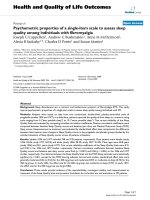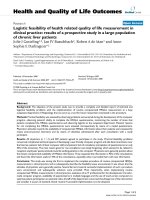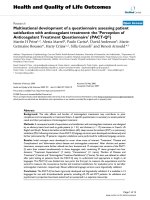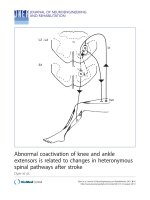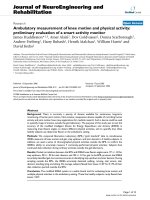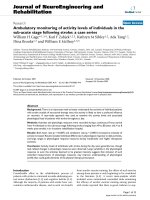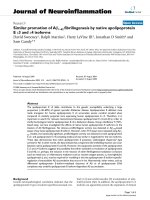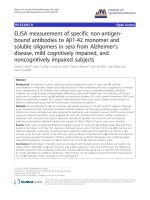báo cáo hóa học: "Ambulatory measurement of knee motion and physical activity: preliminary evaluation of a smart activity monitor" pdf
Bạn đang xem bản rút gọn của tài liệu. Xem và tải ngay bản đầy đủ của tài liệu tại đây (1.05 MB, 10 trang )
BioMed Central
Page 1 of 10
(page number not for citation purposes)
Journal of NeuroEngineering and
Rehabilitation
Open Access
Research
Ambulatory measurement of knee motion and physical activity:
preliminary evaluation of a smart activity monitor
James Huddleston*
1,3
, Amer Alaiti
2
, Dov Goldvasser
2
, Donna Scarborough
2
,
Andrew Freiberg
1
, Harry Rubash
1
, Henrik Malchau
1
, William Harris
1
and
David Krebs
2
Address:
1
Harvard Medical School Harris Orthopaedic Biomechanics and Biomaterials Laboratory Massachusetts General Hospital 55 Fruit Street,
GRJ 1126 Boston, MA 02114–2696,
2
Harvard Medical School Massachusetts General Hospital Biomotion Laboratory MGH Institute of Health
Professionals Charlestown Navy Yard 36 First Avenue, #223 Boston, MA 02129–4557 and
3
Department of Orthopaedic Surgery Stanford
University School of Medicine 300 Pasteur Drive, R-105 Stanford, CA 94305–5341
Email: James Huddleston* - ; Amer Alaiti - ; Dov Goldvasser - ;
Donna Scarborough - ; Andrew Freiberg - ; Harry Rubash - ;
Henrik Malchau - ; William Harris - ; David Krebs -
* Corresponding author
Abstract
Background: There is currently a paucity of devices available for continuous, long-term
monitoring of human joint motion. Non-invasive, inexpensive devices capable of recording human
activity and joint motion have many applications for medical research. Such a device could be used
to quantify range of motion outside the gait laboratory. The purpose of this study was to test the
accuracy of the modified Intelligent Device for Energy Expenditure and Activity (IDEEA) in
measuring knee flexion angles, to detect different physical activities, and to quantify how often
healthy subjects use deep knee flexion in the ambulatory setting.
Methods: We compared Biomotion Laboratory (BML) "gold standard" data to simultaneous
IDEEA measures of knee motion and gait, step up/down, and stair descent in 5 healthy subjects. In
addition, we used a series of choreographed physical activities outside the BML to confirm the
IDEEA's ability to accurately measure 7 commonly-performed physical activities. Subjects then
continued data collection during ordinary activities outside the gait laboratory.
Results: Pooled correlations between the BML and IDEEA knee flexion angles were .97 +/- .03 for
step up/down, .98 +/- .02 for stair descent, and .98 +/- .01 for gait. In the BML protocol, the IDEEA
accurately identified gait, but was less accurate in identifying step up/down and stair descent. During
sampling outside the BML, the IDEEA accurately detected walking, running, stair ascent, stair
descent, standing, lying, and sitting. On average, subjects flexed their knees >120° for 0.17% of their
data collection periods outside the BML.
Conclusion: The modified IDEEA system is a useful clinical tool for evaluating knee motion and
multiple physical activities in the ambulatory setting. These five healthy subjects rarely flexed their
knees >120°.
Published: 13 September 2006
Journal of NeuroEngineering and Rehabilitation 2006, 3:21 doi:10.1186/1743-0003-3-21
Received: 17 June 2005
Accepted: 13 September 2006
This article is available from: />© 2006 Huddleston et al; licensee BioMed Central Ltd.
This is an Open Access article distributed under the terms of the Creative Commons Attribution License ( />),
which permits unrestricted use, distribution, and reproduction in any medium, provided the original work is properly cited.
Journal of NeuroEngineering and Rehabilitation 2006, 3:21 />Page 2 of 10
(page number not for citation purposes)
Background
The complexity of human physical activity has made it
challenging to produce a validated, accurate, and cost-
effective technique to quantify activities of daily living [1-
3]. The value of a sophisticated gait lab is well-established,
but gait labs are expensive, require trained personnel, and
may not simulate normal environments. Of the portable
devices, those with accelerometers are effective in moni-
toring human activity when that activity is known [4-14].
These devices are attractive because they are small, non-
invasive, and inexpensive. Unfortunately, many are not
"smart" enough to determine the type of physical activity
(e.g. stair ascent vs. walking on level ground) that the sub-
ject is performing. Pedometers are generally not sensitive
to differences in stride length and are less accurate when
worn by obese patients [15]. Actometers and wrist/ankle
devices can provide qualitative data via "on" and "off"
switches, but they are limited in their ability to record
quantitative data [14,16,17]. Foot-contact monitors and
electronic load transducers are problematic in their tech-
nical and practical limitations, and no reports exist in the
literature regarding their accuracy in measuring human
physical activity[18].
The Intelligent Device for Energy Expenditure and Activity
system (IDEEA™, MiniSun, LLC), a microcomputer-based
portable physical activity measurement device, allows
detection of multiple gaits, limb movements, and pos-
tures (walk, run, up stairs, down stairs, stand, sit, step,
jump, lie, recline, transition, etc.). It also analyzes gait,
speed, distance, power, work, and energy expenditure. The
IDEEA system's accuracy has been evaluated in previous
investigations [18,19]. Their validation protocol required
subjects to perform a series of choreographed activities.
The timing of these various activities was then recorded
and compared to the IDEEA. The IDEEA system was found
to be accurate in measuring energy expenditure, postures
and limb movements, and speed of walking and running.
The original IDEEA, as described in the investigation
above, was modified for our study by adding two electro-
goniometers.
Various rehabilitation protocols and prosthetic knee
designs assume that knee flexion as measured in laborato-
ries reflects ambulatory knee range of motion, but this
assumption, to our knowledge, has not been tested. In
particular, implant manufacturers now produce "high
flexion" total knee designs that may safely permit up to
150° knee flexion [20-22], but whether even healthy sub-
jects employ these ranges of motion has not been investi-
gated outside gait laboratories. In the present study we
investigated the validity of the modified IDEEA system's
ability to accurately detect physical activities and knee
flexion angles compared to the Massachusetts General
Hospital Biomotion Laboratory (BML). The BML permits
full body analyses of kinematics and kinetics using the
Selspot/TRACK data acquisition system during standing
and locomotion activities, with precision and accuracy of
< 1 mm position and < 1° orientation [23]. We hypothe-
sized that 1) knee flexion angles as reported by the IDEEA
would correlate with knee flexion angles as recorded by
the BML and 2) the IDEEA would accurately detect activi-
ties performed during short choreographed sessions out-
side the BML. Validation of the modified IDEEA in
healthy subjects would corroborate previous investiga-
tions, and in addition provide the error boundaries for use
in determining knee flexion angles and activities of daily
living in the outpatient setting. The ability to evaluate
these parameters at home has numerous potential appli-
cations for patients with disorders of the musculoskeletal
and neurological systems.
Materials and methods
Subjects
A convenience sample of 3 males and 2 females were
included in this study (mean age 43.8 ± 14.5 yrs; body
mass index 24.1 ± 2.9). An orthopaedic surgeon per-
formed a detailed history and physical examination on
the subjects to ensure that none of them had any ortho-
paedic or neurological disorders. The study group con-
sisted of 2 orthopaedic surgeons, one real estate broker,
and 2 members of the BML research team. Our institu-
tional review board approved this study and all subjects
provided written, informed consent.
Instrumentation
Biomotion Lab (BML) System
Subjects' data were captured using a 4-camera Selspot II
optoelectric light-emitting diode (LED) tracking system
(Selective Electronics, Partille, Sweden) and two side-by-
side Kistler piezoelectric force platforms (Kistler Instru-
ments, Winterthur, Switzerland). LED arrays were placed
on the mid-sections of 11 body segments (feet, legs,
thighs, pelvis, trunk, arms and head) enabling globally
referenced, 6 degrees-of-freedom (6 DOF) kinematics to
be captured for each body segment (Figure 1). The LEDs
were sampled at 150 Hz and filtered by using a low-pass
Butterworth filter (4th order, 6-Hz cut-off, zero lag). LED
array trajectories were analyzed by using SUPERTRACK
©
software (Massachusetts General Hospital, Boston, MA)
and resolved into three-dimensional (3D), 6-DOF, body
segment kinematics within the 2 × 2 × 2 meter viewing
volume. Subjects' anatomical data were then used to
transform the global 6 DOF kinematics to 6 DOF body
segment kinematics [24] Body segment mass, center of
mass, and mass moment of inertia were computed from
regression equations using subject-specific anatomical
measurements[23] Segment angular and linear velocities
and accelerations were computed by numerical differenti-
ation of segment position data, and used with segment
Journal of NeuroEngineering and Rehabilitation 2006, 3:21 />Page 3 of 10
(page number not for citation purposes)
mass-inertial data to compute the net joint torques based
on the Newtonian inverse dynamic approach.
IDEEA System
The Intelligent Device for Energy Expenditure and Activity
identifies multiple human physical activities based on
limb movements, postures, transitions, and gaits; it quan-
tifies these physical activities by type, duration, intensity,
and expended energy. The mean and standard deviation
for 18 measured parameters are calculated for right foot,
left foot, and both feet. The device includes 5 sensors
(each 16 × 14 × 4 mm) (Figure 2). The sensors measure
angles and acceleration of body segments in 2 orthogonal
directions. One sensor was placed in the midline approx-
imately 2 cm distal to the sternal notch. One sensor was
placed on the plantar aspect of each foot, proximal to the
metatarsal heads. One sensor was placed on the anterior
surface of each thigh at the mid-femur level (Figures 3 and
4). Hypoallergenic adhesive tape was used to secure the
sensors to the skin. Each sensor was placed with the
proper side against the skin and in line with the longitu-
dinal axis of the body segment. Output signals travel via 2
mm cables to a 33 MHz, 32-bit ARM microprocessor
(ARM, Cambridge, UK) housed in a 7 × 5.4 × 1.7 cm plas-
tic box. The box weighs 59 grams and is worn on one's
belt. Flash memory allows recording of the data during
activities of daily living without loss of data even if unex-
pected power failure occurs. The device operates using a
single AA alkaline battery and consumes approximately
0.045 watts during operation.
At our request, knee electrogoniometers (Penny+Giles™,
Biometrics Ltd., United Kingdom) were added to the sys-
tem by Minisun, LLC. The electrogoniometers measure
knee flexion angles and were calibrated by MiniSun, LLC.
One electrogoniometer was placed on the lateral surface
of each knee, in line with the anatomic axes of the femur
and tibia, and fixed to the skin with hypoallergenic tape
with the knee in 0° extension (as measured by a conven-
tional goniometer). Data collected is downloaded to a
personal computer via a USB connection and a software
interface (provided by Minisun, LLC, the software also
interprets the sensor output and determines activity type
and other variables). With the addition of the electrogoni-
ometers, the IDEEA can operate continuously for up to 48
hours and can store greater than 60 million data points at
32 Hz. The output of the modified IDEEA software gives
the knee flexion angles and, simultaneously, identifies
Photograph of the modified IDEEA systemFigure 2
Photograph of the modified IDEEA system. The two electro-
goniometers (green) were added to the system by MiniSun,
LLC for our study.
Photograph of a subject being tested in the MGH Biomotion Laboratory with both the IDEEA system and LED arrays in placeFigure 1
Photograph of a subject being tested in the MGH Biomotion
Laboratory with both the IDEEA system and LED arrays in
place.
Journal of NeuroEngineering and Rehabilitation 2006, 3:21 />Page 4 of 10
(page number not for citation purposes)
activities (walking, sitting, standing, running, stairs,
recline, transition, etc.) in charts, tables, and "movie-like"
animation. For a specific time interval, as short as 1/32
second, it calculates the time that each different physical
activity was performed.
Protocol
An experienced member of the research team applied the
modified IDEEA to the subject; another team member
confirmed proper placement. Prior to collecting data, the
device was calibrated with the subject sitting in a chair
with the hips and knees in 90° of flexion and the ankles
in neutral dorsiflexion. The proper electrogoniometer
position was again confirmed by a conventional goniom-
eter. Small differences in time between the clocks and
knee angles in the IDEEA system and in the BML were
noted at the time of calibration and corrected during data
analysis.
Five subjects' data were collected using the BML and the
IDEEA simultaneously. Subjects performed each task at
least twice with at least one practice trial prior to data col-
lection. Gait trials consisted of the subjects walking at
their preferred pace along a 10-meter walkway. Stair
descent included descending a four-step modular staircase
of outdoor height (18 × 28 cm) without railings. Stepping
up and down a 7.5 cm height stair was performed at a
metronome cadence of 100 beats per minute for 30 sec
[25].
To simulate a more realistic clinical scenario, we imple-
mented a second protocol requiring subjects to perform a
series of common activities for 30-second intervals out-
side the testing conditions in the BML (no LED arrays).
These activities included: running, walking, sitting,
ascending stairs, descending stairs, standing, and lying.
The exact time that these activities occurred was recorded
by a member of the research team and then compared to
the data generated by the IDEEA system.
After testing in the BML, the LED arrays were removed and
subjects changed back into their street clothes. They then
departed with the IDEEA in place and with instructions to
Photograph (side view) of the modified IDEEA system being worn by a patientFigure 4
Photograph (side view) of the modified IDEEA system being
worn by a patient.
Photograph (front view) of the modified IDEEA system being worn by a patientFigure 3
Photograph (front view) of the modified IDEEA system being
worn by a patient.
Journal of NeuroEngineering and Rehabilitation 2006, 3:21 />Page 5 of 10
(page number not for citation purposes)
perform their daily activities as usual. We requested that
each subject wear the device at least 7 hours and for up to
24 hours. Subjects were permitted to exercise but they
were not allowed to shower or bathe with the device in
place. The majority of data collection outside the BML
occurred while the subjects were at work. One orthopae-
dic surgeon wore the IDEEA during a day in the operating
theatre. The other orthopaedic surgeon wore the device
while seeing patients in clinic. The BML researchers spent
the majority of their data collection period working on a
computer at a desk. The real estate broker transported cli-
ents by car to view residential property.
Data Analysis
Data were processed and analyzed after testing each sub-
ject. The same time interval of BML and IDEEA data was
analyzed for the three specific physical activities (gait,
stepping, and stair descent). Pearson correlation was used
to compare the knee flexion angles recorded by the BML
and the IDEEA. Choreographed activities outside the BML
were checked against the reporting of the IDEEA for the
known time intervals.
Results
The subjects used the IDEEA (including time during test-
ing in the BML) for an average of 17.4 +/- 9.7 hours
(range, 7.5–33 hours). Two subjects wore the device over-
night while sleeping. Figure 5 summarizes the various
activities performed by all subjects while awake. Subjects
took an average of 8,441 +/- 4,785 steps (range, 4,369–
14,715 steps) per session. Table 1 quantifies the various
activity parameters recorded by the IDEEA system during
each subject's entire data collection period.
The pooled correlations between the BML and the IDEEA
system knee flexion angles were .98 +/- .01 for gait, .98 +/
- .02 for stair descent, and .97 +/- .03 for step up/down
(Figures 6, 7, 8). Four of 5 subjects flexed their knees
>120° at any time during their data collection periods.
Two subjects recorded knee flexion >160°, both during
sitting with their foot underneath their contralateral but-
tock. Time spent at >120° of knee flexion averaged 58 +/-
39 seconds (range, 0–267 seconds). This time spent at
knee flexion >120° represented, on average, 0.17 % of
each subject's testing session. Figure 9 shows the number
of occurrences of various knee flexion angles, for one sub-
ject, during the data collection period outside the BML.
In testing during the choreographed sessions outside the
gait laboratory, the IDEEA accurately reported activity for
all 5 subjects in all trials (Table 2). While testing in the
BML protocol, the IDEEA system accurately identified the
gait trial in all five subjects. It correctly identified stair
descent in three of the five subjects. For the stair descent
trials of the other two subjects, the IDEEA incorrectly
reported their activity as "walking". The IDEEA identified
stepping up/down correctly in only two of the five sub-
jects. It incorrectly reported "walking" during the step up/
down trials for the other three subjects (Table 3).
Discussion
The frequency that healthy subjects use deep knee flexion
outside the laboratory setting is currently unknown. We
sought to validate the modified IDEEA system by using
the Selspot/TRACK data acquisition system in a laboratory
and in subjects' natural environments. In the laboratory,
we limited our examination to knee motion and 3 activi-
ties in 5 healthy subjects, as it is these data that hold the
most relevance to prosthetic device research. Our results
indicate that the IDEEA system, when compared to the
gold-standard gait laboratory, is able to accurately report
knee flexion angles. During BML testing it was able to
accurately report gait, but it was less accurate in recording
stair descent and step up/down. However, during testing
outside the BML, the IDEEA accurately identified walking,
running, standing, sitting, stair ascent, stair descent, and
lying in the five subjects.
The inability of the IDEEA system to accurately detect stair
descent and step up/down during laboratory testing may
be due to the limitations inherent in our protocol. The
size of the data collection area restricts both the activity
type and duration of activity that can be evaluated. This
size constraint limits our stair model to 4 steps. MiniSun
states that 4 steps are too few to allow the IDEEA to con-
firm this activity. We know that we diminished the esti-
mate of accuracy by limiting the maximum time available
for activity detection. However, this was done in an effort
to perform a highly standardized data analysis, as has pre-
viously been the basis for prosthetic knee design. Moreo-
ver, during the stepping protocol, subjects stepped
forwards and backwards, a task IDEEA is not currently
designed to detect.
Our results of testing for activity identification outside the
BML protocol corroborate previous investigations
[18,19]. In their validation of the IDEEA system, the
authors used a timed protocol of specific activities to
measure postures, limb movements, and jumping. They
evaluated stair ascent and descent by timing subjects on
the stairs at two different speeds. In combining the IDEEA
with the flexible electrogoniometers, we have created a
tool capable of determining, among others, the amount of
knee flexion needed for activities that are commonly-per-
formed outside the gait laboratory.
The pooled correlations between IDEEA and BML knee
angles during step up/down, gait, and descending stairs
ranged from .93 to .99. These data suggest that the IDEEA
accurately measures knee motion during these three activ-
Journal of NeuroEngineering and Rehabilitation 2006, 3:21 />Page 6 of 10
(page number not for citation purposes)
ities. The electrogoniometers proved to be durable, as
none of the devices failed to collect data after the subjects
exited the gait laboratory.
The data recorded by the modified IDEEA system confirm
that some patients flex their knee >120° and that the sys-
tem is capable of recording deep knee flexion angles up to
160°. Four of 5 subjects flexed their knee > 120° during
routine activities. Two subjects flexed their knees >160°
while sitting on a chair with their foot curled under the
contralateral buttock. On average, these five subjects spent
0.17 % of their testing session with their knees in >120°
of knee flexion. These data must be interpreted cautiously,
as we only tested 5 subjects who performed jobs that do
not regularly require deep knee flexion. The subjects may
have used knee flexion >120° more often if they had been
evaluated on a weekend or holiday.
Conclusion
We found that the modified IDEEA system, compared to
the Selspot/TRACK data acquisition system in the MGH
BML, accurately reported healthy subjects' knee range of
motion. The IDEEA system was also able to accurately
detect walking, running, standing, sitting, stair climbing,
stair descent, and lying during choreographed activities
outside the BML. The results of the present study, in con-
junction with previous reports, support the use of the
modified IDEEA system in the outpatient setting. In the
future, we plan to use the IDEEA system to evaluate knee
motion and frequency and duration of activities of daily
living in patients who have had total knee arthroplasty.
This approach may eventually allow for the assessment of
surgical outcomes for different prosthetic designs.
Table 1: General Activity Parameters Measured by IDEEA
Subject Session Duration (hours) Steps (#) Distance (km) Speed (m/min) Energy Expenditure (kcal/minute)
1 11.5 5670 4.4 9.9 2.7
2 7.4 4997 3.8 16.0 2.8
3 18.7 4369 4.0 5.6 2.4
4 16.1 14,715 11.0 16.3 2.2
5 33 12,452 9.3 10.5 1.8
mean 17.4 +/- 9.7 8441 +/- 4785 6.5 +/- 3.4 11.7 +/- 4.5 2.4 +/- 0.4
This histogram shows the average time (%) that the 5 subjects spent performing various activities during their data collection periods outside the BMLFigure 5
This histogram shows the average time (%) that the 5 subjects spent performing various activities during their data collection
periods outside the BML.
Journal of NeuroEngineering and Rehabilitation 2006, 3:21 />Page 7 of 10
(page number not for citation purposes)
This graph shows the knee flexion angles, for one subject, recorded simultaneously by the IDEEA and the BML during 3 trials of stair descentFigure 7
This graph shows the knee flexion angles, for one subject, recorded simultaneously by the IDEEA and the BML during 3 trials of
stair descent.
This graph shows the knee flexion angles, for one subject, recorded simultaneously by the IDEEA and the BML during 3 trials of gaitFigure 6
This graph shows the knee flexion angles, for one subject, recorded simultaneously by the IDEEA and the BML during 3 trials of
gait.
Journal of NeuroEngineering and Rehabilitation 2006, 3:21 />Page 8 of 10
(page number not for citation purposes)
Abbreviations
IDEEA Intelligent Device for Energy Expenditure and
Activity
BML Biomotion Laboratory
Competing interests
The author(s) declare that they have no competing inter-
ests.
Authors' contributions
JH developed the ideas discussed in this paper, recruited
subjects, performed the experiments, analyzed the data,
and drafted the manuscript under the guidance of AF, HR,
HM, WH, and DK. DG and DS performed the experi-
ments, analyzed the data, and assisted in revising the
manuscript. AF, HM, and HR assisted in revising the man-
uscript. WH conceived the study and assisted in revising
the manuscript. DK conceived the study, recruited sub-
jects, performed the experiments, supervised the BML
experiments, and assisted in analyzing the data and revis-
ing the manuscript. All authors read and approved the
final manuscript.
Acknowledgements
The authors thank Patrick Duplessis for his assistance with data analysis.
Written consent was obtained from the subjects (Figures 1, 3, and 4) for
publication of the study.
References
1. Wilson PW, Paffenbarger RSJ, Morris JN, Havlik RJ: Assessment
methods for physical activity and physical fitness in popula-
tion studies: report of a NHLBI workshop. Am Heart J 1986,
111:1177-1192.
2. Washburn RA, Montoye HJ: The assessment of physical activity
by questionnaire. Am J Epidemiol 1986, 123:563-576.
This graph shows the number of times that one subject (JH) reached various knee flexion angles during his data collection period outside the BMLFigure 9
This graph shows the number of times that one subject (JH)
reached various knee flexion angles during his data collection
period outside the BML.
This graph shows the knee flexion angles, for one subject, recorded simultaneously by the IDEEA and the BML during 3 trials of stepping up and down on a single stepFigure 8
This graph shows the knee flexion angles, for one subject, recorded simultaneously by the IDEEA and the BML during 3 trials of
stepping up and down on a single step.
Publish with BioMed Central and every
scientist can read your work free of charge
"BioMed Central will be the most significant development for
disseminating the results of biomedical research in our lifetime."
Sir Paul Nurse, Cancer Research UK
Your research papers will be:
available free of charge to the entire biomedical community
peer reviewed and published immediately upon acceptance
cited in PubMed and archived on PubMed Central
yours — you keep the copyright
Submit your manuscript here:
/>BioMedcentral
Journal of NeuroEngineering and Rehabilitation 2006, 3:21 />Page 9 of 10
(page number not for citation purposes)
3. Paffenbarger RSJ, Blair SN, Lee IM, Hyde RT: Measurement of
physical activity to assess health effects in free-living popula-
tions. Med Sci Sports Exerc 1993, 25:60-70.
4. Levine JA, Baukol PA, Westerterp KR: Validation of the Tracmor
triaxial accelerometer system for walking. Med Sci Sports Exerc
2001, 33:1593-1597.
5. Bassey EJ, Dallosso HM, Fentem PH, Irving JM, Patrick JM: Validation
of a simple mechanical accelerometer (pedometer) for the
estimation of walking activity. Eur J Appl Physiol Occup Physiol
1987, 56:323-330.
6. Bouten CV, Westerterp KR, Verduin M, Janssen JD: Assessment of
energy expenditure for physical activity using a triaxial accel-
erometer. Med Sci Sports Exerc 1994, 26:1516-1523.
7. Janz KF: Validation of the CSA accelerometer for assessing
children's physical activity. Med Sci Sports Exerc 1994,
26:369-375.
8. Meijer GA, Westerterp KR, Verhoeven FM, Koper HB, ten Hoor F:
Methods to assess physical activity with special reference to
motion sensors and accelerometers. IEEE Trans Biomed Eng
1991, 38:221-229.
9. Melanson ELJ, Freedson PS: Physical activity assessment: a
review of methods. Crit Rev Food Sci Nutr 1996, 36:385-396.
10. Melanson ELJ, Freedson PS: Validity of the Computer Science
and Applications, Inc. (CSA) activity monitor. Med Sci Sports
Exerc 1995, 27:934-940.
11. Nichols JF, Patterson P, Early T: A validation of a physical activity
monitor for young and older adults. Can J Sport Sci 1992,
17:299-303.
12. Seedhom BB, Wallbridge NC: Walking activities and wear of
prostheses. Ann Rheum Dis 1985, 44:838-843.
13. Sequeira MM, Rickenbach M, Wietlisbach V, Tullen B, Schutz Y: Phys-
ical activity assessment using a pedometer and its compari-
son with a questionnaire in a large population survey. Am J
Epidemiol 1995, 142:989-999.
14. Wallbridge N, Dowson D: The walking activity of patients with
artificial hip joints.
Eng Med 1982, 11:95-96.
15. Schmalzried TP, Szuszczewicz ES, Northfield MR, Akizuki KH, Frankel
RE, Belcher G, Amstutz HC: Quantitative assessment of walking
activity after total hip or knee replacement. J Bone Joint Surg
Am 1998, 80:54-59.
16. Saris WH, Binkhorst RA: The use of pedometer and actometer
in studying daily physical activity in man. Part I: reliability of
pedometer and actometer. Eur J Appl Physiol Occup Physiol 1977,
37:219-228.
17. Saris WH, Binkhorst RA: The use of pedometer and actometer
in studying daily physical activity in man. Part II: validity of
pedometer and actometer measuring the daily physical
activity. Eur J Appl Physiol Occup Physiol 1977, 37:229-235.
18. Zhang K, Pi-Sunyer FX, Boozer CN: Improving energy expendi-
ture estimation for physical activity. Med Sci Sports Exerc 2004,
36:883-889.
19. Zhang K, Werner P, Sun M, Pi-Sunyer FX, Boozer CN: Measure-
ment of human daily physical activity. Obes Res 2003, 11:33-40.
20. Li G, Most E, Sultan PG, Schule S, Zayontz S, Park SE, Rubash HE:
Knee kinematics with a high-flexion posterior stabilized total
knee prosthesis: an in vitro robotic experimental investiga-
tion. J Bone Joint Surg Am 2004, 86-A:1721-1729.
21. Yamazaki J, Ishigami S, Nagashima M, Yoshino S: Hy-Flex II total
knee system and range of motion. Arch Orthop Trauma Surg
2002, 122:156-160.
22. Huang HT, Su JY, Wang GJ: The early results of high-flex total
knee arthroplasty: a minimum of 2 years of follow-up. J
Arthroplasty 2005, 20:674-679.
23. Kaleps I, Clauser CE, Young JW, Chandler RF, Zehner GF, McConville
JT: Investigation into the mass distribution properties of the
human body and its segments. Ergonomics 1984, 27:1225-1237.
Table 2: Accuracy of Activity Identification Outside BML
Known Activity Activities by Subject as Reported by IDEEA
12345
walk walk walk walk walk walk
run run run run run run
stair ascent step up step up step up step up step up
stair descent step down step down step down Step down step down
lie lie lie lie lie lie
stand stand stand stand stand stand
sit sit sit sit sit sit
Table 3: Activity as Reported by IDEEA during BML Protocol
Subject ID Gender Step Trial Gait Trial Stair Descent Trial
1 M walk walk step down
2 M walk walk step down
3 F step up walk walk
4 M step up walk walk
5 F walk walk step down
Publish with BioMed Central and every
scientist can read your work free of charge
"BioMed Central will be the most significant development for
disseminating the results of biomedical research in our lifetime."
Sir Paul Nurse, Cancer Research UK
Your research papers will be:
available free of charge to the entire biomedical community
peer reviewed and published immediately upon acceptance
cited in PubMed and archived on PubMed Central
yours — you keep the copyright
Submit your manuscript here:
/>BioMedcentral
Journal of NeuroEngineering and Rehabilitation 2006, 3:21 />Page 10 of 10
(page number not for citation purposes)
24. Riley PO, Mann RW, Hodge WA: Modelling of the biomechanics
of posture and balance. J Biomech 1990, 23:503-506.
25. Goldvasser D, McGibbon CA, Krebs DE: Vestibular rehabilitation
outcomes: velocity trajectory analysis of repeated bench
stepping. Clin Neurophysiol 2000, 111:1838-1842.

